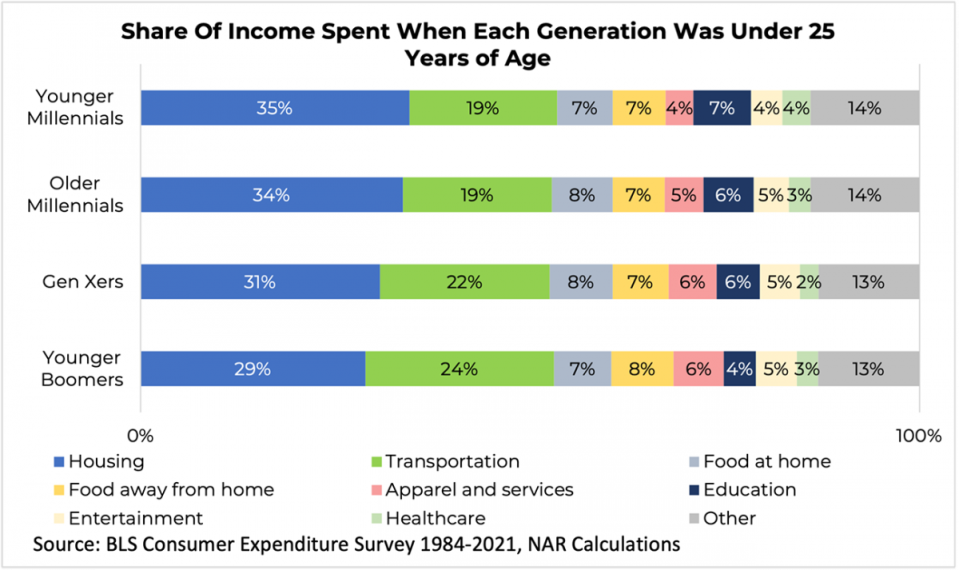Millennials are flooding the housing market. But what (and where) are they buying? That depends.
Whether it's their love of avocado toast or their struggles to leave their parents' basements, millennials have been the butt of endless jokes over the last decade.
But now, these adults – those born between 1981 and 1998 – have not only emerged from those cellars, but they are also the largest group of homebuyers today, making up 37% of the overall share in 2021, according to data from the National Association of Realtors.
So it make sense for realtors, homebuilders and baby boomers looking to sell homes to pay attention to this group's homebuying habits and preferences, says Jessica Lautz, vice president of demographics and behavioral insights for the National Association of Realtors.
Here are findings from the 2021 National Association of Realtors' Home Buyers and Sellers Generational Trends report based on responses from 8,212 homebuyers who purchased a primary residence between July 2019 and June 2020.
Homeowner? Make that twice over
In the current hot housing market, millennials have been active buyers despite multiple hurdles like stiff competition, a shortage of homes, and the challenge of bidding against other buyers who don't need a bank loan and can pay all cash.
Not only that, most of them are repeat customers.
While 82% of younger millennials (ages 22 to 30) are first-time buyers, the majority (52%) of older millennials (aged 31-40) are repeat buyers.
These are millennials who are in their prime spending years and starting families.
"Many of them were moving to larger homes," says Lautz.
►'I am living in a nightmare everyday': Homeowners and weather-related home insurance
►Is a housing crash coming? Eight experts weigh in on the possibility
Suburbs vs. urban centers
Fifty-four percent of homes purchased by homebuyers 31 to 40 – older millennials – were in a suburb or subdivision. Being close enough to an urban center was important with "convenience to workplace" being cited by 74% of younger millennials (22 to 30) saying that was the deciding factor.
While environmentally friendly features were important to them, such as efficient heating and cooling systems, commuting costs were of the utmost importance when deciding on a home, with 44% of younger millennials and 38% of older millennials ranking it above energy-efficient appliances, solar panels and energy-efficient lighting.
"The younger millennials overwhelmingly answered that they prefer to live closer to work, as many don't want a long commute and this was evident in their buying habits," says Lautz.
►Living the NYC dream:How remote work enabled these young workers to live their best life

A helping hand
Millennials were most likely to receive financial assistance from a relative or a friend, compared with other generations.
Twenty-three percent of younger millennials and 17% of older millennials received a gift from family or friends to buy a home. However, the majority used savings and nearly one-third of older millennials used proceeds from their past home sale for the down payment.

Hurdles to homeownership
“What we are seeing from the data is that millennials do have a lot of hurdles to enter homeownership, not just housing affordability and low inventory today but also due to student loan debt and high rental costs,” says Lautz.
For the first time on record, rental price growth rose by double digits, increasing 11.5% year over year to a median of $1,633 in August, according to a recent Realtor.com report, making it harder to save for a down payment.
Among successful homebuyers, 43% of younger millennials and 37% of older millennials had student loan debt, with median amounts of $25,000 and $33,000, respectively. These buyers were able to enter the housing market, but they had to make financial sacrifices and find more affordable locations, and some did receive parental help.
Buyers who had student debt, purchased homes that were 19% less expensive than those without student debt, even when controlling for family help, size, and location of the home purchased.
Fixer-uppers are not a deal-breaker
Twenty-five percent of younger millennials said they compromised on the condition of a home, the most of any group, according to National Association of Realtors data.
"What we do see is that millennials as homebuyers are actually purchasing older homes that need a little bit of work," says Lautz. "It makes it more affordable."
So if baby boomers, who are currently the largest generation of home sellers, are listing a home that needs work, they likely will still find a buyer.
"If you don't have the time or the desire to put money into retrofitting the home before you list it for sale," says Lautz. "There may be a younger millennial who's willing to undertake DIY (Do-it-yourself) projects and repairs."
Swapna Venugopal Ramaswamy is the housing and economy reporter for USA TODAY. Follow her on Twitter @SwapnaVenugopal
This article originally appeared on USA TODAY: Millennials flood housing market. But where and what are they buying?
